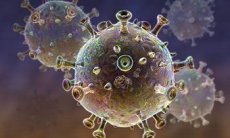Medical expert of the article
New publications
Epidemic mumps virus (mumps)
Last reviewed: 06.07.2025

All iLive content is medically reviewed or fact checked to ensure as much factual accuracy as possible.
We have strict sourcing guidelines and only link to reputable media sites, academic research institutions and, whenever possible, medically peer reviewed studies. Note that the numbers in parentheses ([1], [2], etc.) are clickable links to these studies.
If you feel that any of our content is inaccurate, out-of-date, or otherwise questionable, please select it and press Ctrl + Enter.

Epidemic parotitis (mumps) is an acute viral disease characterized by damage to one or both parotid salivary glands. The pathogen was isolated in 1934 by K. Johnson and R. Goodpasture from the saliva of a patient with mumps by infecting monkeys into the salivary gland duct.
Morphologically, the virus is similar to other paramyxoviruses, has hemagglutinating, hemolytic, neuraminidase and symplast-forming activity. The genome is represented by single-stranded non-fragmented negative RNA, m. m. its 8 MD. The virion contains 8 proteins; supercapsid proteins HN and F perform the same functions as in other paramyxoviruses. The virus reproduces well in the amniotic cavity of 7-8-day chicken embryos and in cell cultures, better primary trypsinized, with the formation of symplasts. The antigenic structure of the virus is stable, no serovariants have been described.
The virus is unstable and is destroyed within a few minutes when exposed to fat solvents, detergents, 2% phenol, 1% lysol and other disinfectants. Laboratory animals are insensitive to the mumps virus. Only in monkeys, by introducing the virus into the salivary gland duct, can a disease similar to human mumps be reproduced.
Pathogenesis and symptoms of mumps
Mumps has an incubation period of 14-21 days on average. The virus penetrates from the oral cavity through the stenotic (parotid) duct into the parotid salivary gland, where it mainly reproduces. It is possible that the primary reproduction of the virus occurs in the epithelial cells of the upper respiratory tract. Entering the blood, the virus can penetrate into various organs (testicles, ovaries, pancreas and thyroid glands, brain) and cause corresponding complications (orchitis, meningitis, meningoencephalitis, less often - thyroiditis, polyarthritis, nephritis, pancreatitis; severe forms of orchitis can cause subsequent sexual sterility). The most typical symptoms of mumps: inflammation and enlargement of the parotid and other salivary glands, accompanied by a moderate increase in temperature. As a rule, in uncomplicated cases, mumps ends in complete recovery. Very often it is asymptomatic.
Post-infectious immunity is strong, long-lasting, and there are almost no recurrent diseases. Natural passive immunity lasts for the first six months of a child's life.
Epidemiology of mumps
Mumps is found everywhere. The source of infection is only a sick person (including those with an asymptomatic form of the disease). He is contagious during the entire incubation period and the first week of the disease. Children aged 5-15 years (more often boys) are ill, but adults can also get sick.
Laboratory diagnostics of mumps
Virological and serological diagnostics of mumps are used, using saliva, urine, cerebrospinal fluid, gland puncture. 7-8-day chicken embryos or cell cultures are infected. The virus is identified using hemagglutination inhibition (hemadsorption), immunofluorescence, neutralization and complement fixation reactions. Serological diagnostics of mumps is carried out based on the increase in antibody titer in paired sera of patients using RTGA or RSK.
Specific prevention of mumps
According to the International Service for Disease Eradication, mumps is a potentially eradicated disease. The main means of eradicating it is the creation of collective immunity using a live vaccine prepared from an attenuated strain (passages on chicken embryos lead to a decrease in the pathogenicity of the virus for humans). The vaccine is administered subcutaneously once to children in the first year of life; immunity is as stable as post-infection. Rubella and measles are also considered potentially eradicated diseases. Therefore, the use of a trivalent vaccine ( vaccination against measles, rubella and mumps ) is recommended for the eradication of mumps.


 [
[